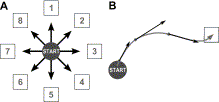Copyright © 2009 Elsevier Ltd All rights reserved.
Available online 7 August 2009.
Abstract
Brain-machine interfaces (BMIs) can be characterized by the technique used to measure brain activity and by the way different brain signals are translated into commands that control an effector. We give an overview of different approaches and focus on a particular BMI approach: the movement of an artificial effector (e.g. arm prosthesis to the right) by those motor cortical signals that control the equivalent movement of a corresponding body part (e.g. arm movement to the right). This approach has been successfully applied in monkeys and humans by accurately extracting parameters of movements from the spiking activity of multiple single-units. Here, we review recent findings showing that analog neuronal population signals, ranging from intracortical local field potentials over epicortical ECoG to non-invasive EEG and MEG, can also be used to decode movement direction and continuous movement trajectories. Therefore, these signals might provide additional or alternative control for this BMI approach, with possible advantages due to reduced invasiveness.
Keywords: Directional tuning; Decoding; SUA; MUA; LFP; ECoG; EEG; MEG; BMI; BCI
Article Outline
- 1. Introduction
- 1.1. Brain-machine interfaces
- 1.2. Different BMI approaches
- 1.2.1. Recording techniques
- 1.2.2. Mental task or strategy
- 1.2.3. Direct motor BMI
- 2. Directional tuning
- 2.1. Directional tuning in spiking signals: SUA and MUA
- 2.2. Amplitude spectrograms of analog population signals
- 2.3. Directional tuning in analog population signals: LFP, ECoG, EEG, MEG
- 3. Movement decoding
- 3.1. Movement decoding using analog population signals: movement direction
- 3.2. Movement decoding using analog population signals: movement trajectories
- 4. Discussion
- 4.1. Relevance of low-pass filtered analog neural population signals
- 4.2. Directional tuning of signals reflecting a wide range of spatial scales: from SUA to EEG/MEG
- 4.3. Online direct motor BMI and adaptivity
- Acknowledgements
- Appendix A
- A.1. Deduction of the expected amplitude of a cosine created by the sum of cosines with random phases
- A.2. Deduction of the noise amplitude resulting from summation of noise
- References
 Corresponding
authors. Address: Faculty of Biology, Hauptstr. 1, 79104 Freiburg,
Germany. Tel.: +49 761 203 2542; fax: +49 761 203 2921 (S. Walbert),
tel.: +49 761 203 2543; fax: +49 761 203 2921 (C. Mehring).
Corresponding
authors. Address: Faculty of Biology, Hauptstr. 1, 79104 Freiburg,
Germany. Tel.: +49 761 203 2542; fax: +49 761 203 2921 (S. Walbert),
tel.: +49 761 203 2543; fax: +49 761 203 2921 (C. Mehring).1 These authors contributed equally to the manuscript.
High accuracy remote eye tracking
for perception research and new HCI
www.interactive-minds.com
Electrode arrays for neural
recording/stimulation/drug delivery
www.NeuroNexusTech.com











 E-mail Article
E-mail Article Add to my Quick Links
Add to my Quick Links




 2
min), (2) precisely adjust dichoptical stimulation by evaluating
offsets between monocular and binocular CRF positions (average spatial
incongruency between binocular and left/right eye stimulation after
calibration:
2
min), (2) precisely adjust dichoptical stimulation by evaluating
offsets between monocular and binocular CRF positions (average spatial
incongruency between binocular and left/right eye stimulation after
calibration: 










